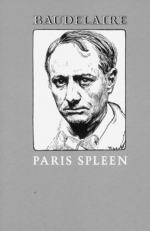
|
| Name: _________________________ | Period: ___________________ |
This test consists of 15 multiple choice questions and 5 short answer questions.
Multiple Choice Questions
1. Why does the narrator of "The Mirror" question the man looking into a mirror?
(a) Because the mirror is not his.
(b) Because he is ugly.
(c) Because he is not smiling at himself.
(d) Because it is raining and he is outside.
2. Why does the first beautiful woman die young in "Which is the Real One?"
(a) Because of her beauty.
(b) Because she was beaten.
(c) Because of an illness.
(d) Because of an accident.
3. What do most of the passengers on the boat in "Already!" say when they see land?
(a) Finally.
(b) Already.
(c) What?
(d) It's true.
4. How does Baudelaire make the legend in "Windows"?
(a) From writing about the old woman.
(b) From watching the old woman.
(c) From peering into his neighbors' windows.
(d) From taking frequent naps.
5. Because of the Moon's actions in "The Favors of the Moon", what happens to the child's skin?
(a) It has a yellow tint.
(b) It becomes pale.
(c) It starts to sparkle.
(d) It is covered with freckles.
6. What does the poet say lurks at night in "The Desire to Paint"?
(a) The unknown.
(b) Women.
(c) Stars.
(d) Predators.
7. In "Windows", how does Baudelaire say he feels about the legend?
(a) As if he has suffered for it.
(b) As if it teaches him daily.
(c) As if it saves his life.
(d) As if it is not true at all.
8. How does Baudelaire describe the thyrsus in "The Thyrsus"?
(a) Lost.
(b) Beautifully sad.
(c) All-powerful.
(d) A plaything.
9. Where do the men leave in the beginning of "Counterfeit Money"?
(a) A church.
(b) A tobacco shop.
(c) A town hall.
(d) An inn.
10. In "The Eyes of the Poor", what does the narrator first say to the woman?
(a) That she is not beautiful any longer.
(b) That she is late.
(c) That he hates her.
(d) That he will not yell at her.
11. In "Get Yourself Drunk", what does Baudelaire say slavery is?
(a) Earth.
(b) Relationships.
(c) Time.
(d) Money.
12. In "Beautiful Dorothy", why is Dorothy saving money?
(a) To go on vacation.
(b) To attract a husband.
(c) To move to Paris.
(d) To buy back her sister.
13. What part of the child does the Moon touch in "The Favors of the Moon"?
(a) Her hands.
(b) Her feet.
(c) Her face.
(d) Her back.
14. In "A Heroic Death", why does the Prince want to save Fancioulle's life?
(a) Because his lord tricked him.
(b) Because of his performance at court.
(c) Because he is so young.
(d) Because he knows he is innocent.
15. In "Counterfeit Money", what does the man call his friend's stupidity?
(a) Trickery.
(b) Pride.
(c) Evil.
(d) Foolishness.
Short Answer Questions
1. How does the man lose his halo in "Loss of a Halo"?
2. What does the narrator of "The Eyes of the Poor" remember the woman doing when she saw the poor man?
3. In "The Port", who is described as coming into the port?
4. In "Mademoiselle Bistouri", what does the woman ask the man?
5. In "Windows", what type of window does the poet say is most interesting to look in?
|
This section contains 551 words (approx. 2 pages at 300 words per page) |

|




